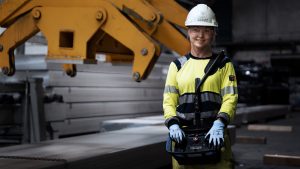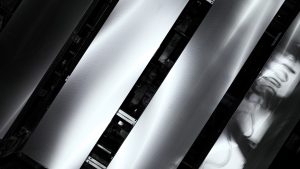Speira defends transparency and sustainability by leveraging advanced technology and AI in its recycling process, improving efficiency, reducing carbon emissions, and providing detailed information on the ecological impacts of its products.
Last year we had our first “transparent” oven at our Hamburg factory. Its special feature is the integration of cutting-edge industry 4.0 technology. Innovative sensor and camera technologies provide real-time insights into all furnace processes, and data obtained in this way allows for continuous optimization of operation and burner control adapted to the mixing of scrap and primary metal used. Based on constant monitoring of melts, operators supported by artificial intelligence are given ideal times for example alloying and dross removal. Measured parameters also allow hydraulic components to be used with less wear and tear, allowing for targeted, predictive maintenance, reducing downtime and further improving plant efficiency.
After some time, I was able to decide to invest in four new tiltable rotary furnaces at the recycling factory. Again, artificial intelligence is used for industrial use. A learning fee-Mix optimization solution designed to increase operational efficiency, reduce costs and optimize scrap mixes. The more accurate the process is considered, the more transparency and efficiency the more efficient the process is, the better the ecological and economic performance. The more transparent you are, the better the decisions you can draw from it.
This applies to internal processes and external relationships. At Speira, we believe sustainability and transparency are two aspects of the same coin. Because we want our customers to make it as simple as possible to determine the lowest carbon, the most circular aluminum. Again, informed decisions are the best decisions, so they are transparent and consistent about the research, decisions and convictions that guide product design. This was outlined in the article, “Sustainability and Transparency, Consistently Connected.”
Dorothea Flockert, head of Sustainability, who just released Speira’s first sustainability report, explained:
Orbis and Rivos: Certified Labels for Sustainable Solutions
We are always working to redefine the limits of aluminum and produce each product with as much recycled content as possible. We want our customers to be able to rely on this ambition. Third-party certified and uses at least 75% of external scrap. We have created the most circular product labels that embody resource efficiency and reuse. With unwavering transparency, Orbis defends a more sustainable future and paves the way for a closed loop. Orbis is more than just a label. It is a testament to our commitment to creating a functional circular world!

With a clear focus on carbon footprint and transparency, we took another step. Once again, we have been certified as a third party and designed it to allow our customers to choose the most sustainable aluminum. By combining external scrap with low carbon primary metals tailored to local opportunities for sustainable energy use, it maximizes resource efficiency and minimizes product carbon footprint. We call it rivos, bringing us and our customers a step closer to Net Zero.
Already, many Speira products can provide detailed sustainability profiles. You will receive a product data sheet with delivery. This is not only the chemical composition and precise batch of the alloy, but also the exact proportion of internal, front, post-consumer scrap, recycled alloys, and individual ecological footprints broken into the slab and finished coils. This is the transparency we want to measure ourselves and set as a benchmark.
Build a functional cyclical world
Speira ended primary production after 62 years, and is fully focused on recycling aluminum. Our business model is to achieve savings of up to 95% in energy and CO2 in this process compared to primary production. We would like to use this “decarburizing lever” in as many ways as possible. Around 75% of the aluminum produced so far around the world is still used in several applications and is one of the most recycled metals, with over 30 million tonnes of recycled annually. So, what are we doing to improve this 75% towards a complete circulation at Speira? It’s not about closing one loop. By closing all loops, our material is not lost, but is completely recovered from the application and sent into a new lifecycle with permanent quality.
We strive to ensure as much terminal scrap as possible. To this end, we are constantly investing in existing and new recycling equipment, and have far more recycling capabilities than the NEUS main production was already at its peak. And the trend is still upwards. We operate one of the world’s most modern plants to recycle beverage cans at the very site of an old smelter. And the more frequently the materials are recycled in this plant, the more the technical advantages of the UBC line can be converted to CO2 savings. The drink is ideally suited for this due to its short life cycle and its mature closure (seed) system in Western Europe. “Back to the shelf in 60 days,” drink aluminum returns up to six times a year, starting a new life cycle for the plant.
But there is also facility and process expertise to recycle things that others can’t hold in the loop. This includes severely contaminated scraps, such as well-known coffee capsules, such as oil-based, painted, and plastic metals. It also recovers as much aluminum as possible from the slag and dross. Our Rød and Raudsand plants provide this very special recycling service to the entire Norwegian aluminum industry.

We transform our linear business model into a circular business model by directly recycling process scrap along with our customers, the direct aluminum processor. “Aluminum from customers back to us” manages the supply chain as carefully as output to customers.
We also aim to ensure that we are as recycled as possible, and consider not only the aluminum material, but also the alloy metals used in customized solutions. Especially when it comes to copper, we rely on recycled metals. This is particularly energy and resource intensive in primary production. And we operate our own recycling line for magnesium at our target factory.
Redefine the limits of aluminum
We put the argument to “redefine the limits of aluminum” in our customer-development partnership. We’ll look at existing and potential applications. This is where can you use primary aluminum or recycled aluminum, which has been used so far with completely different materials? Of the customized alloys, can you best meet the specific requirements of your application, while at the same time ensuring the optimal product balance with the highest percentage of recycled materials? For example, our recycled alloys via Maris Njørdal have recently been found to have a 15% higher strength compared to standard high strength alloys for shipbuilding, with 15% less material usage and therefore less fuel consumption, while improving Vessel’s performance.
The appeal of RFA – recycling-friendly alloys – does not only provide customers with solutions with the least ecological footprint possible. Also, reclaiming the alloy at the end of the lifecycle makes it possible to start a new lifecycle as easily as possible. For decades, our industry has exploited the possibilities of increasingly specialized alloys to achieve the physical properties of final products. The drawback of this is the enormous complexity of various alloys in the market and in recycling.

So we want to redefine the limits of aluminum through the second route. That is, the formation of physical properties through post-casting treatments and treatments, such as annealing, curing, hot rolling, and cold rolling. We consider this an exciting opportunity to simplify chemical composition over the long term and provide the same number of special applications with less overall different alloys. And this again reduces the complexity of recycling and creates a world of circulation that works even easier.
The potential for circulation is very large. Because decarbonization levers are so effective, they want to use them in as many ways as possible. We want to walk through the doors that are already open with an equally ambitious partner!
This article will also be featured in the 23rd edition of Quarterly Publication.
Source link

